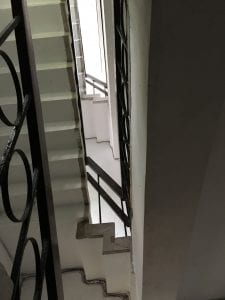20 April 2020
My body’s defenses have been penetrated—not by the virus, but by xenobiotics, substances foreign to human bodies.


In order to disinfect the public area of our four-floor apartment building, my neighbor has sprayed bleach all over the stairways. I discerned the bleach right away due to the acrid smell that not only quickly permeated the public spaces of the building, but also directly entered my home. I knew the smell of bleach, but I hadn’t experienced it in such an unbearably pungent form as this before. Maybe it had not been diluted with the right proportions. The air started to make me cough, and I could feel my throat burning. There was no place to hide. There was no way out, since the smell would overwhelm me if I even tried to open the door. Not a single room in my home allowed me to isolate myself from the bleach since it was diffused throughout the air. I used to believe that staying at home during the time of the epidemic was the only way to breathe freely, since you have to wear a mask when going out. However, after being suffocated by my neighbor’s concentrated bleach solution, I realized that boundaries are ever fluctuating, in ways surpassing my expectations. The boundaries of home were supposed to be solid—however, during this epidemic, I realized that they are easily penetrated, even by bleach symbolizing the anxiety of sanitization.
When outside of my home, I often encounter the gaze of mechanical eyes, under which I am detected as a juxtaposition of colors.
Whenever I pass through the infrared thermometer gates of the university, gym, or shopping mall, I watch myself being transformed into a figure constituted by yellow and green lumps of color. The infrared scanner captures me not as a human, but as a strange entity emitting heat and infrared rays. I look like a Homo sapiens specimen in the eyes of humans, but not in the eyes of non-humans, these infrared scanners. How the world looks totally depends upon the sensory capabilities that one possesses. For the infrared scanners, I imagine their world looks like an Andy Warhol-style piece of artwork—contrasting colors collide with each other, creating a landscape with infinite colors that can’t be detected by human eyes.
The bleach eliminates the boundary between a breathable inside and an unbreathable outside, whereas infrared thermometer gates set up boundaries between the outside and the inside, between exclusion and inclusion. Only those who don’t appear “red” —indicating an overly high body temperature—are allowed in.
The machines see what humans can’t see. The chemicals cause physical reactions beyond your expectations. With human-object relations as one of my research interests, these immediate experiences remind me about the posthumanist call to recognize that humans are subject to the agencies of materials. It is what Stacy Alaimo refers as “trans-corporeality.” Trans-corporeality entails thinking of human subjects as inextricably interconnected with materials and substances around them. As a posthuman feminist scholar, Alaimo acknowledges the permeability of human beings. That is, the boundary that defines what it means to be human and our sense of self is not as clear as we imagine it to be; instead, it can be penetrated, restructured, and reassembled by the material agencies that surround us. Our bodily existence, the energy flows within us, are just substances interwoven with the material complexities that we inhabit. For example, Alaimo refers to allergies to certain chemicals as trans-corporeal experiences causing people to undergo strange agencies that lurk within seemingly harmless objects.
When I am choked by the bleach, and when I am filtered through the lens of infrared scanners, the concept of trans-corporeality becomes perfectly clear to me. During the time of the epidemic, we are not only endeavoring to set up boundaries to block the virus, but also in the process of rearranging our relationships with non-human agents. The virus urges us to face our permeability and vulnerability, taking us on a departure from the anthropocentric humanities toward trans-corporeal posthumanities. In short, we will no longer think only of human-centered consciousness, but will pay more attention to our connection with non-human entities.
Hsin-Hui Lin is a Ph.D. student at the National Chengchi University Graduate Institute of Taiwanese Literature. Her research concerns the relationship between literary texts and ecological and technological humanities. Hsin-Hui’s MA thesis The Cyborg Reading of Contemporary Taiwanese Literature received the 2017 Annual MA Thesis Award of the National Museum of Taiwanese Literature. She once worked as editor at Unitas Literary, one of the major literary magazines in Taiwan. As a fiction writer, she has won several literary awards in Taiwan for her short stories. Her short story collection Human Glitches 《瑕疵人型》is forthcoming in Chinese in June 2020.
Related:
Diary Project Taipei [1] :: Hsin-Hui Lin (Taiwan)
Diary Project Taipei [3] :: Hsin-Hui Lin (Taiwan)
Diary Project Taipei [4] :: Hsin-Hui Lin (Taiwan)
* * *
The Teach311 + COVID-19 Collective began in 2011 as a joint project of the Forum for the History of Science in Asia and the Society for the History of Technology Asia Network and is currently expanded in collaboration with the Max Planck Institute for the History of Science(Artifacts, Action, Knowledge) and Nanyang Technological University-Singapore.
![[Teach311 + COVID-19] Collective](https://blogs.ntu.edu.sg/teach311/files/2020/04/Banner.jpg)